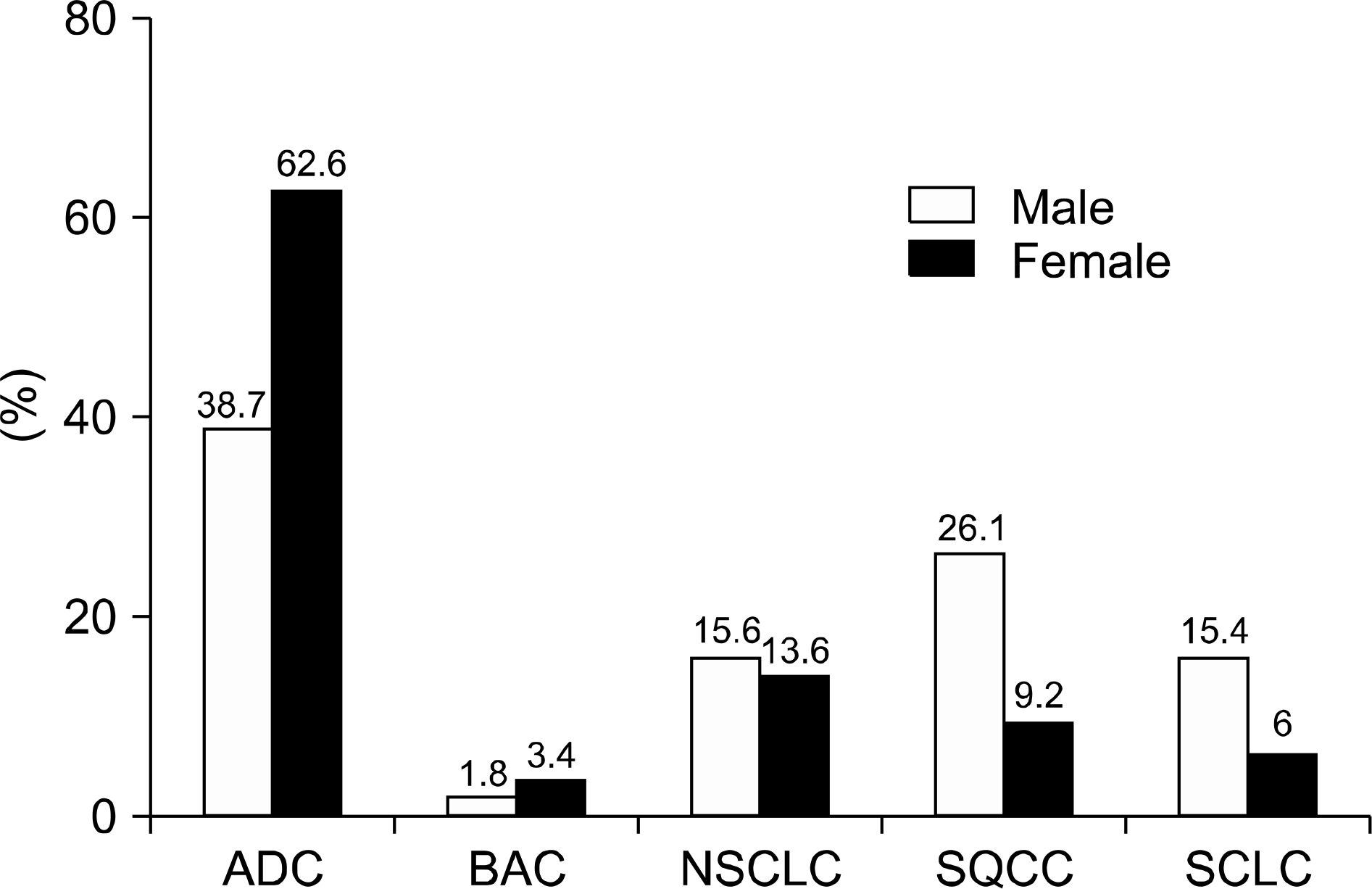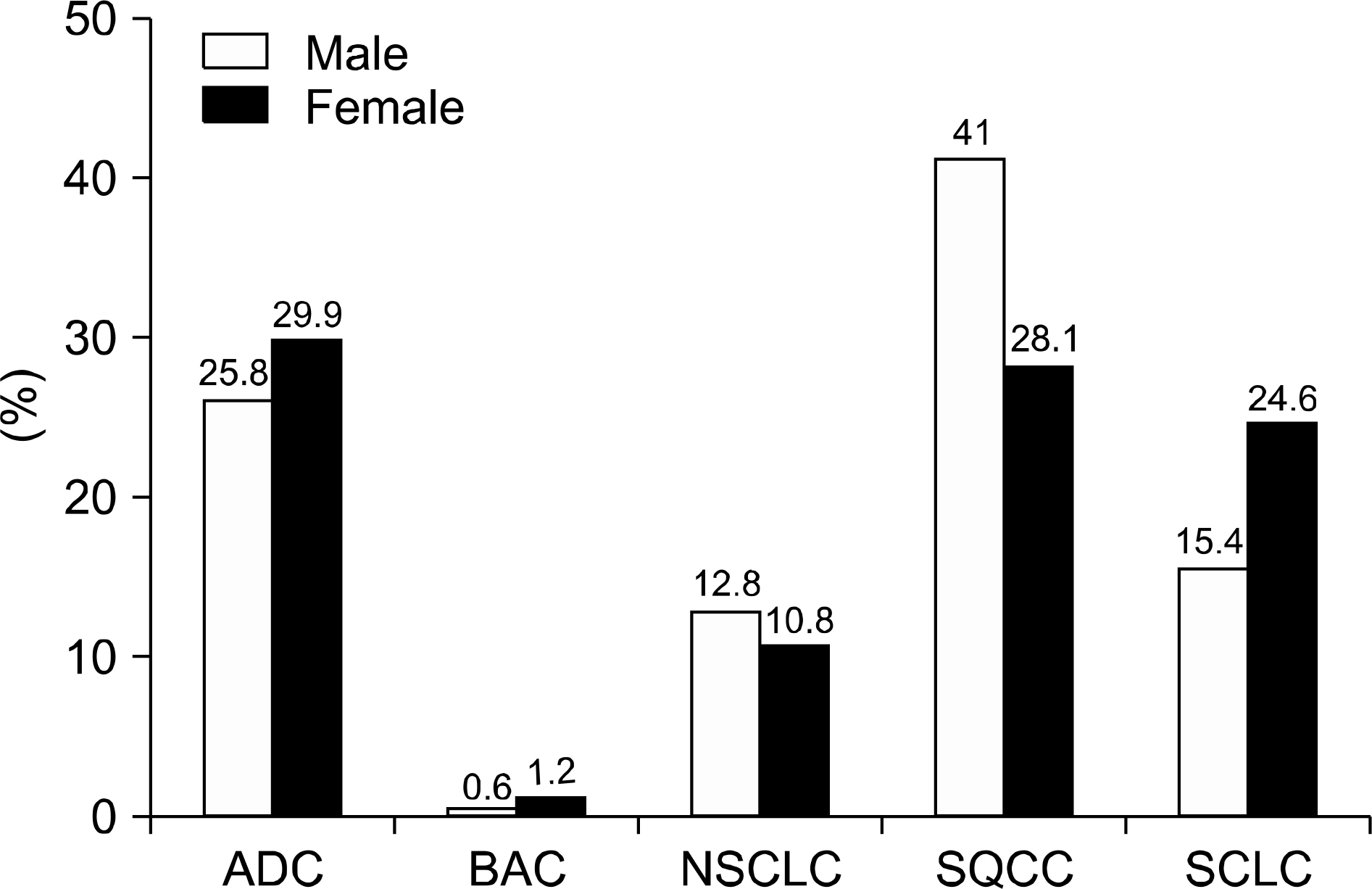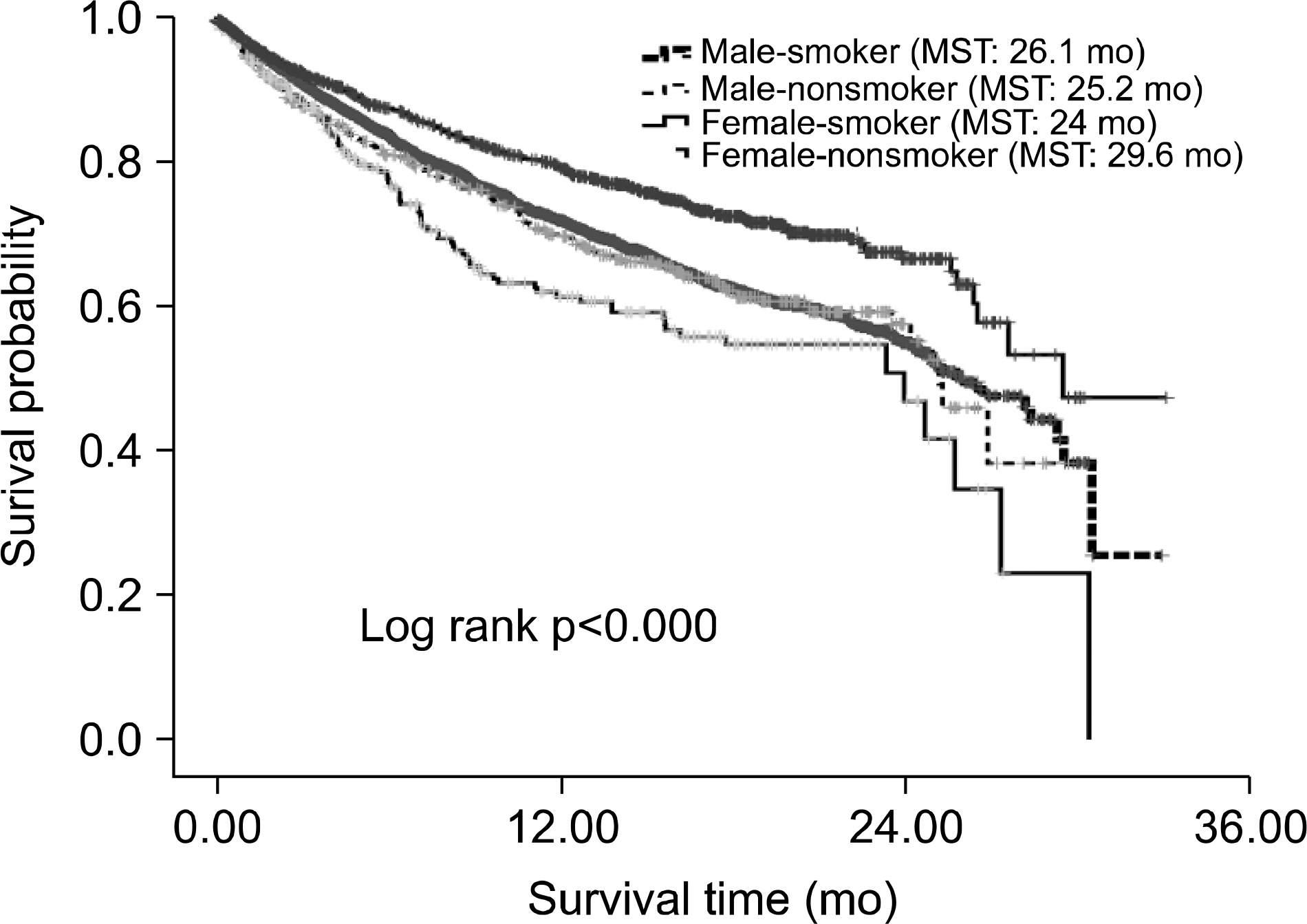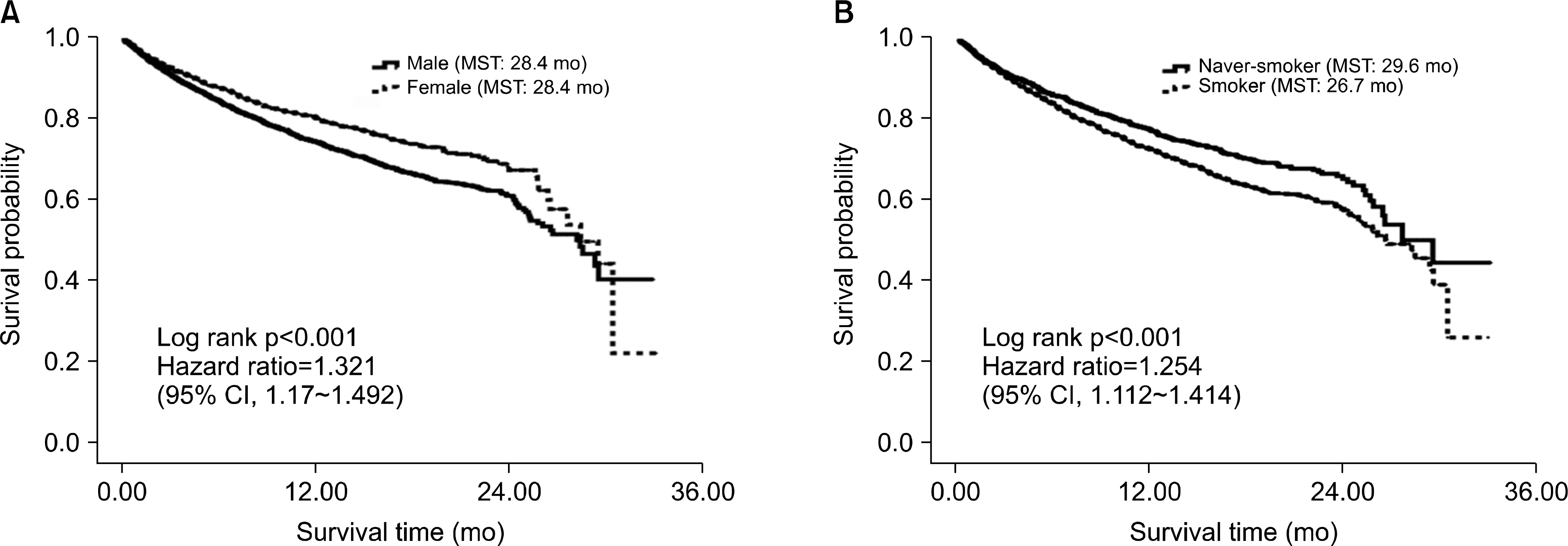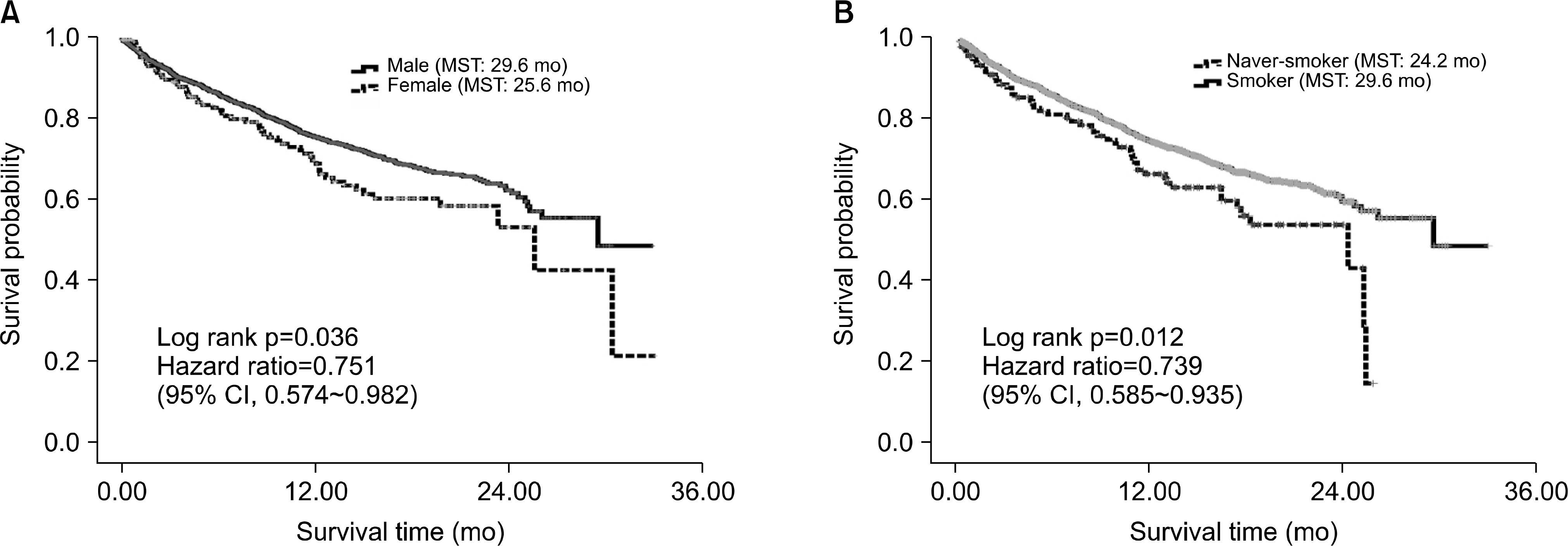J Lung Cancer.
2010 Dec;9(2):57-63. 10.6058/jlc.2010.9.2.57.
Female Lung Cancer: Re-Analysis of National Survey of Lung Cancer in Korea, 2005
- Affiliations
-
- 1Kosin University, Korea.
- 2Chonnam National University, Korea.
- 3Chungnam National University, Korea.
- 4Inha University, Korea.
- 5Inje University, Korea.
- 6Yeungnam University, Korea.
- 7Yonsei University, Korea.
- 8Korea University, Korea.
- 9Wonkwang University, Korea.
- 10The Survey Committee of Korean Association for the Study of Lung Cancer, Korea. jaymh@dreamwiz.com
- KMID: 2199903
- DOI: http://doi.org/10.6058/jlc.2010.9.2.57
Abstract
- PURPOSE
Female lung cancers have different clinical features and therapeutic results as compared to those of male lung cancers. The aim of this study was to analyze the differences of Korean men and women with lung cancer.
MATERIALS AND METHODS
We re-analyzed the results of a national survey of lung cancer conducted by the Korean Association for the Study of Lung Cancer in 2005.
RESULTS
Of the 8,788 patients, 2,124 (24.2%) were female. The mean age at the diagnosis was 62.5 years for the females and 64.8 years for the males and the difference was significant (p<0.001). An age <50 years was more frequent for the women than for the men (16.2% vs. 7.9%, respectively; p=0.001). The stages between genders were different for the patients with non-small cell carcinoma (NSCLC) (p<0.001), but not for the patients with small cell carcinoma. The overall survival time was longer for woman than that for the man (p<0.001). However, the male patients had longer survival for the smokers with adenocarcinoma and the smokers with squamous cell carcinoma. The never smoker female patients had a better survival time than did the smoking female patients, but the male patient' survival was not influenced by the smoking status. The stage-specific survival rates were better for the women at all stages of NSCLC (p<0.001). The women who received chemotherapy had a longer survival time did the men who received chemotherapy (p<0.001).
CONCLUSION
Women with lung cancer were relatively overrepresented among the younger patients and they smoked less intensively, raising the question of gender- specific differences in the carcinogenesis of lung cancer. Over-representation of adenocarcinoma was observed in the women regardless of their smoking status. Women with lung cancer had a better prognosis than men; however, the smoking females showed the worst prognosis. Gender and the smoking status are clearly important factors in the therapeutic approach to lung cancer.
Keyword
MeSH Terms
Figure
Cited by 1 articles
-
Characteristics of Peripheral versus Central Lung Cancer Since 2000
So Young Ock, Tae Won Jang, You Jin Han, Go Eun Yeo, Eun Jung Kim, Won Hyoung Lee, Nam Kyu Kim
Kosin Med J. 2014;29(1):47-52. doi: 10.7180/kmj.2014.29.1.47.
Reference
-
References
1. Jemal A, Murray T, Ward E, et al. Cancer statistics, 2005. CA Cancer J Clin. 2005; 55:10–30.
Article2. Fiore MC, Novotny TE, Pierce JP, Hatziandreu EJ, Patel KM, Davis RM. Trends in cigarette smoking in the United States. The changing influence of gender and race. JAMA. 1989; 261:49–55.
Article3. Visbal AL, Williams BA, Nichols FC 3rd, et al. Gender differences in nonsmall-cell lung cancer survival: an analysis of 4,618 patients diagnosed between 1997 and 2002. Ann Thorac Surg. 2004; 78:209–215.
Article4. Nobello S, Brahmer JR, Stabile LP, Siegfried JM. Gender-related differences in lung cancer. Pass HI, Carbone DP, Johnson DH, editors. Principles and practice of lung cancer. 4th ed.Philadelphia: Lippincott Williams & Wilkins;2010. p. 353–368.5. Korean National Statistical Office. Annual report on the cause of death statistic. Daejeon: Korean National Statistical Office;2007.6. Scientific Committee of Korean Academy of Tuberculosis and Respiratory Disease. The national survey of lung cancer in Korea. Tuberc Respir Dis. 1999; 46:455–465.7. Kim YC, Kwon YS, Oh IJ, et al. National survey of lung cancer in Korea, 2005. J Lung Cancer. 2007; 6:67–73.
Article8. Minami H, Yoshimura M, Miyamoto Y, Matsuoka H, Tsubota N. Lung cancer in women: sex-associated differences in survival of patients undergoing resection for lung cancer. Chest. 2000; 118:1603–1609.9. de Perrot M, Licker M, Bouchardy C, Usel M, Robert J, Spiliopoulos A. Sex differences in presentation, management, and prognosis of patients with nonsmall cell lung carcinoma. J Thorac Cardiovasc Surg. 2000; 119:21–26.
Article10. Radzikowska E, Gł az P, Roszkowski K. Lung cancer in women: age, smoking, histology, performance status, stage, initial treatment and survival. Population-based study of 20 561 cases. Ann Oncol. 2002; 13:1087–1093.
Article11. Fu JB, Kau TY, Severson RK, Kalemkerian GP. Lung cancer in women: analysis of the national Surveillance, Epidemiology, and End Results database. Chest. 2005; 127:768–777.12. Boyle P, Ferlay J. Cancer incidence and mortality in Europe, 2004. Ann Oncol. 2005; 16:481–488.
Article13. Badar F, Meerza F, Khokhar RA, et al. Characteristics of lung cancer patients–the Shaukat Khanum Memorial experience. Asian Pac J Cancer Prev. 2006; 7:245–248.14. Strauss GM, Ahmedin J, McKenna MB, Strauss JA, Cummings KM. The epidemic of smoking-related adenocarcinoma of the lung: the role of the tobacco industry and filtered and low-tar cigarettes: PRS-01. J Thorac Oncol. 2007; 2:S305.15. Yu IT, Chiu YL, Au JS, Wong TW, Tang JL. Dose-response relationship between cooking fumes exposures and lung cancer among Chinese nonsmoking women. Cancer Res. 2006; 66:4961–4967.
Article16. Má rquez-Garbá n DC, Chen HW, Fishbein MC, Goodglick L, Pietras RJ. Estrogen receptor signaling pathways in human nonsmall cell lung cancer. Steroids. 2007; 72:135–143.
Article17. Rivera MP, Stover DE. Gender and lung cancer. Clin Chest Med. 2004; 25:391–400.
Article18. International Early Lung Cancer Action Program Investigators. Henschke CI, Yip R, Miettinen OS. Women's susceptibility to tobacco carcinogens and survival after diagnosis of lung cancer. JAMA. 2006; 296:180–184.19. Johnson BE, Steinberg SM, Phelps R, Edison M, Veach SR, Ihde DC. Female patients with small cell lung cancer live longer than male patients. Am J Med. 1988; 85:194–196.
Article20. Kim HK, Yook DS, Shin HS, et al. Analysis of prognostic factors related to survival time for patients with small cell lung cancer. Tuberc Respir Dis. 2003; 54:57–70.
Article21. Kure EH, Ryberg D, Hewer A, et al. p53 mutations in lung tumours: relationship to gender and lung DNA adduct levels. Carcinogenesis. 1996; 17:2201–2205.22. Ryberg D, Hewer A, Phillips DH, Haugen A. Different susceptibility to smoking-induced DNA damage among male and female lung cancer patients. Cancer Res. 1994; 54:5801–5803.23. Wisnivesky JP, Halm EA. Sex differences in lung cancer survival: do tumors behave differently in elderly women? J Clin Oncol. 2007; 25:1705–1712.
Article24. Albain KS, Crowley JJ, LeBlanc M, Livingston RB. Survival determinants in extensive-stage nonsmall-cell lung cancer: the Southwest Oncology Group experience. J Clin Oncol. 1991; 9:1618–1626.
Article25. Lord RV, Brabender J, Gandara D, et al. Low ERCC1 expression correlates with prolonged survival after cisplatin plus gemcitabine chemotherapy in nonsmall cell lung cancer. Clin Cancer Res. 2002; 8:2286–2291.

